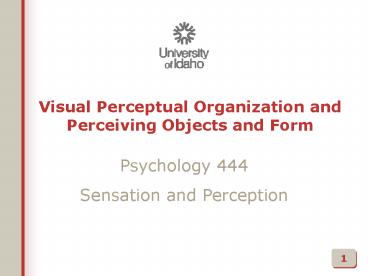Visual Perceptual Organization and Perceiving Objects and Form - PowerPoint PPT Presentation
1 / 19
Title:
Visual Perceptual Organization and Perceiving Objects and Form
Description:
Grouping based on Simplicity: The Gestalt Laws ... Desimone et al. (1985) single-cell recordings from Macaque IT. 18. Visual Attention ... – PowerPoint PPT presentation
Number of Views:173
Avg rating:3.0/5.0
Title: Visual Perceptual Organization and Perceiving Objects and Form
1
Visual Perceptual Organization and Perceiving
Objects and Form
2
Week 6 Outline
- Bottom-up vs. Top-Down Processing
- Perceiving Figure and Ground
- Grouping based on Simplicity The Gestalt Laws
- Constructivism and Grouping based on the
Likelihood Principle - Schemes for Representing Objects
- Physiology of Perceiving Objects
- Attention and Perception
- Failures of object Recognition Visual Agnosia
3
Bottom-up vs. Top-Down Processing
- My wife and mother-in-law
- http//psylux.psych.tu-dresden.de/i1/kaw/diverses
20Material/www.illusionworks.com/html/perceptual_a
mbiguity.html - Do you see the wife (young woman) or
mother-in-law (older woman)? - Interpretation of Ambiguous stimuli can change
depending on context
4
Top-Down vs. Bottom-up Processing
- Top-down
- Conceptually-driven, perception based on
information (concepts) coming from previous
experience, stored in memory - Bottom-up
- data-driven, perception guided by information
(data) currently coming in through the senses - All perception is based on some combination of
these two factors - Perceptual Priming
5
Perception of Figure Ground
- First step in perceiving objects and forms is to
segregate an object (figure) from the background - Sometimes this relationship is obvious
- Sometimes this relationship is ambiguous
- face-vase figure
- Art by Escher, Dali, others
6
Ambiguous Figure Ground in Art Dalis Slave
Market with the Disappearing Bust of Voltaire
7
Perceptual Organization Perceiving Figure and
Ground
- Qualities of figure
- Quality of a thing
- Contours appear at and define edges
- Appears closer than and in front of the ground
- Appears more impressive, dominant, and better
remembered (Figure 7.5) - Suggests meaningful shape
- Qualities of ground
- Quality of a substance
- Appears relatively formless
- Appears to extend continuously behind the figure
- Unnoticed
- shapeless
8
Figure-Ground, Lightness and Contrast Perception
- Do the gray circles on the right look lighter or
darker than the gray background on the left? - Wolff effect Figure is perceived as lighter than
ground
9
Figure-Ground, Lightness and Contrast Perception
- Koffka rings Figural properties (top-down) can
overcome effects of simultaneous contrast
(bottom-up)
10
Other determinants of Figure-Ground
- Symmetrical areas more often seen as figure
- Convex shapes seen as figure
- Smaller areas seen as figure
- Canonical orientations (H and V) - Figure 7.4 a
- Meaningful objects - Figure 7.4b
11
Grouping based on Simplicity The Gestalt Laws
- The law of Pragnanz or good figure
- We perceive the simplest organization of a
stimulus - goodness can be defined in terms of information
theory (Hochberg and McAlister, 1953) - 4 simple shapes (3 circles and 1 equilateral
triangle) or - 3 complex shapes (more parameters needed to
define) - Considered to be largely fundamental, unlearned,
organizing principles bottom-up
12
The Gestalt Laws
- nearness (proximity)
- Similarity
- Connectedness
- good continuation
- common fate ?
- Symmetry
- Closure
13
Grouping based on Likelihood Constructivism
- The constraint of likelihood and Constructivist
Approach - We perceive the most likely (probable)
organization of a stimulus - Likelihood is based on context and prior
experience - top-down - Helmholtzs unconscious inference
- Gregory perception as hypothesis testing
- Active observation and eye movements
14
Likelihood Impossible Figures
15
Representing Objects
- Template Matching Models
- View-dependent or view-invariant
- View-dependent store limited number of 2D
canonical views and interpolate between them
(Rock, 1997) - View-invariant 3D object templates
- Geons (Biederman, 1987)
- Structural Descriptions (Marr and Nishihara, 1978)
16
Physiology of Form Perception
- Grandmother cells vs. Population (ensemble)
coding - Ventral (occipital-temporal) Stream
- Input from both parvo and magno systems
- Structure from dynamic information ?
- Infero-temporal cortex (IT, Desimone et al.,
1984) - Large receptive fields
- Receptive fields cross midline
- Receptive fields tuned to respond preferentially
to shape
17
Desimone et al. (1985) single-cell recordings
from Macaque IT
18
Visual Attention
- Internal spotlight used to select or enhance
some information at the cost of ignoring or
degrading other information - Generally we attend where we are looking, but
attentional spotlight can be moved independently
of eye - Attentional state modifies the responses of
visual neurons throughout extra-striate cortex
and can modify responses in striate cortex - Attention modulates responses of IT neurons by
linking spatial location to object shape
19
Failures of object Recognition Visual Agnosia
- Agnosia failure to recognize objects despite
registration of visual information in cortex - The man who mistook his wife for a hat -
Oliver Sacks - Sub-Types
- Apperceptive agnosia failure due to perceptual
problems in representation often due to damage
of right parietal lobe - Problems with unusual views
- Problems with interpreting shadows
- Associative agnosia failure despite normal
representation often due to damage of posterior
left hemisphere (occipital) - Can draw accurate pictures of viewed objects
- Cannot identify objects
- Prosopagnosia Failure to recognize faces
- Generally results from lesions of
temporal-occipital areas - Right-hemisphere may be more important
- Can be specific to human faces only (patient
W.J.)































